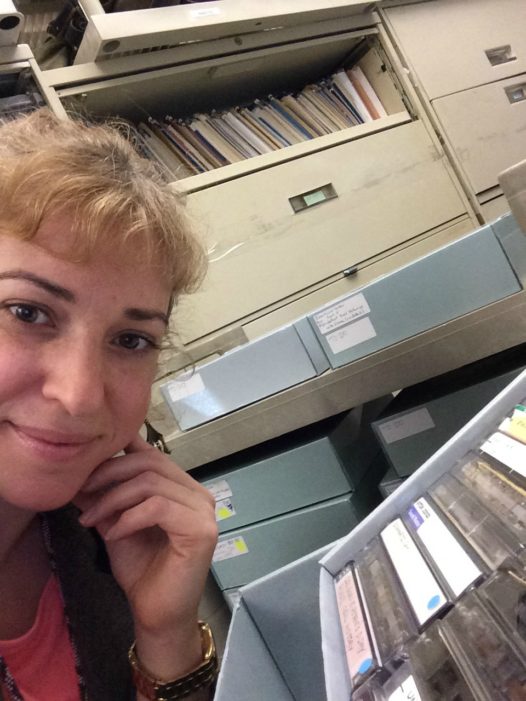 In Jennifer Waxman’s line of work, a slow, steady hand is a necessity. Otherwise, a little bit of history can be wiped away.
In Jennifer Waxman’s line of work, a slow, steady hand is a necessity. Otherwise, a little bit of history can be wiped away.
“Every time you move something, there is a risk of damage,” says Waxman, archives manager at the National World War II Museum. “The more you turn a page in a book, the weaker the bonds get on the paper and in the binding.
“A lot of the material we have is very brittle, it’s been through a war,” she adds “so if you lift it up the wrong way, the brittle paper could just rip accidentally. So you have to remind yourself constantly to take it easy, take it slow, be more gentle.”
But a deliberate pace can be a problem if the workload is piling up. “There’s an efficiency issue in the profession and that’s come up a lot over the years,” says Waxman. “We write articles about how to be better managers, and there’s a lot of new theories in processing collections and how to get it done faster. It’s about priorities and it’s about trying to figure out which collection can withstand that kind of faster processing.”
She says there’s also a tension between preservation and access. “You have this desire to love and protect and to hold your material for the long term by giving it appropriate housing, cataloguing it correctly, making sure it’s identified, and you have all the information about it so you don’t lose it.
“But then you do want to provide access to it. We deal with [the conflict] all the time. We start talking about it in grad school, basically.”
Waxman studied history as an undergrad and graduate student. “But then I realized that you can focus on just archival management, very similar to just going to library school and becoming archives focused. So instead of the library science track, I went into history and got a very extensive training in archival studies.”
She followed that up with training in information science workshops and post-grad work, ramping up her library science credentials in order to work in all kinds of institutions, from libraries to archives to museums, she said.
A lot of her daily work at the World War II museum involves the processing of collections that come in. “So when we get some material, I have to identify it, catalog it, and rehouse it and put it on the shelves for long term storage – and provide access to that for future researchers and curators.”
The material that comes in is unique, she adds, in that the museum’s collections aren’t homogenous. “Most archival collections, typically that I’ve worked on in the past, are just a lot of paper, boxes of paper. But for our collections we get uniforms, patches, paper, pamphlets, bound volumes, metal, wood, paper, plastic, all varieties of material, and you can‘t really store it all together. So its important to make sure it’s in the right spot according to its needs for long-term preservation.”
And with advancing technology, the methods of preserving something for the long-term continue to evolve – that means digitizing collections, and then updating those collections to fit the current, highest quality format, says Waxman.
Despite her experience in the field, there are still times when Waxman finds herself astonished at the history she holds in her hands – items like a 14th century Ethiopian Bible while working at the Rare Books Library in the Archives of the American University in Cairo, or a hand-drawn org chart of the Nazi SS. “It’s just hand-drawn on file folders, from a General or Lieutenant, probably from when he was in prison, and it was evidence later in the Nuremburg trials.”
Or more recently, when she helped move a Sherman tank from one building at the museum to another. “I put the mats under it, and I got to reassemble the gun on top.”
She did not, however, get to drive it. “You’ve got to go to tank school for that,” she says. “I’m not on that list yet.”
 NOLAbeings Multimedia artist Claire Bangser created NOLAbeings as a portrait-based story project that marries...
NOLAbeings Multimedia artist Claire Bangser created NOLAbeings as a portrait-based story project that marries...  Voodoo in New Orleans: Reviving history: New Orleans fortune telling This article takes a deep dive into the history of Voodoo in New Orleans, its hybridization with Catholicism, and its present-day place in the city's culture. The author visits fortune-tellers in the French Quarter, using their guidance as a tool for introspection rather than a deterministic predictor of the future. Through her experiences in New Orleans, the author feels a mystical connection to both the past and the future.
Voodoo in New Orleans: Reviving history: New Orleans fortune telling This article takes a deep dive into the history of Voodoo in New Orleans, its hybridization with Catholicism, and its present-day place in the city's culture. The author visits fortune-tellers in the French Quarter, using their guidance as a tool for introspection rather than a deterministic predictor of the future. Through her experiences in New Orleans, the author feels a mystical connection to both the past and the future. 